brake light MERCEDES-BENZ CLS 2010 Owners Manual
[x] Cancel search | Manufacturer: MERCEDES-BENZ, Model Year: 2010, Model line: CLS, Model: MERCEDES-BENZ CLS 2010Pages: 308, PDF Size: 5.71 MB
Page 6 of 308
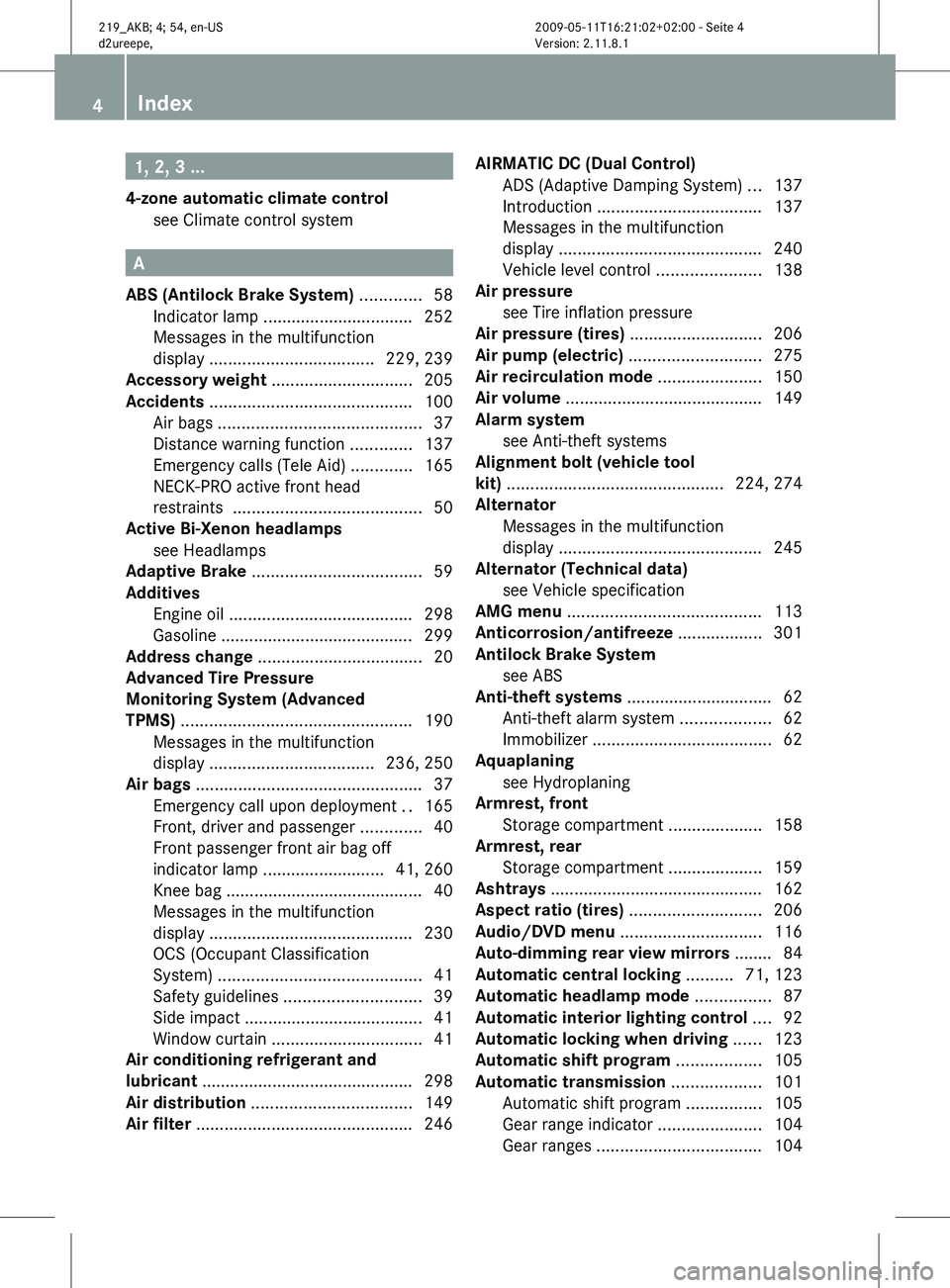
1, 2, 3 ...
4-zone automatic climate control see Climate control system
A
ABS (Antilock Brake System) .............58
Indicator lamp ................................
252
Messages in the multifunction
display ................................... 229, 239
Accessory weight .............................. 205
Accidents ........................................... 100
Air bags ........................................... 37
Distance warning function .............137
Emergency calls (Tele Aid) ............. 165
NECK-PRO active front head
restraints ........................................ 50
Active Bi-Xenon headlamps
see Headlamps
Adaptive Brake .................................... 59
Additives Engine oil ....................................... 298
Gasoline ......................................... 299
Address change ................................... 20
Advanced Tire Pressure
Monitoring System (Advanced
TPMS) ................................................. 190
Messages in the multifunction
display ................................... 236, 250
Air bags ................................................ 37
Emergency call upon deployment ..165
Front, driver and passenger ............. 40
Front passenger front air bag off
indicator lamp .......................... 41, 260
Knee bag .......................................... 40
Messages in the multifunction
display ........................................... 230
OCS (Occupant Classification
System) ........................................... 41
Safety guidelines ............................. 39
Side impact ...................................... 41
Window curtain ................................ 41
Air conditioning refrigerant and
lubricant ............................................. 298
Air distribution .................................. 149
Air filter .............................................. 246AIRMATIC DC (Dual Control)
ADS (Adaptive Damping System) ...137
Introduction
................................... 137
Messages in the multifunction
display ........................................... 240
Vehicle level control ...................... 138
Air pressure
see Tire inflation pressure
Air pressure (tires) ............................ 206
Air pump (electric) ............................ 275
Air recirculation mode ......................150
Air volume .......................................... 149
Alarm system see Anti-theft systems
Alignment bolt (vehicle tool
kit) .............................................. 224, 274
Alternator Messages in the multifunction
display ........................................... 245
Alternator (Technical data)
see Vehicle specification
AMG menu ......................................... 113
Anticorrosion/antifreeze ..................301
Antilock Brake System see ABS
Anti-theft systems ............................... 62
Anti-theft alarm system ................... 62
Immobilizer ...................................... 62
Aquaplaning
see Hydroplaning
Armrest, front
Storage compartment ....................158
Armrest, rear
Storage compartment ....................159
Ashtrays ............................................. 162
Aspect ratio (tires) ............................ 206
Audio/DVD menu .............................. 116
Auto-dimming rear view mirrors ........ 84
Automatic central locking ..........71, 123
Automatic headlamp mode ................87
Automatic interior lighting control ....92
Automatic locking when driving ......123
Automatic shift program ..................105
Automatic transmission ................... 101
Automatic shift program ................105
Gear range indicator ......................104
Gear ranges ................................... 1044
Index 219_AKB; 4; 54, en-US
d2ureepe,
Version: 2.11.8.1 2009-05-11T16:21:02+02:00 - Seite 4
Page 13 of 308
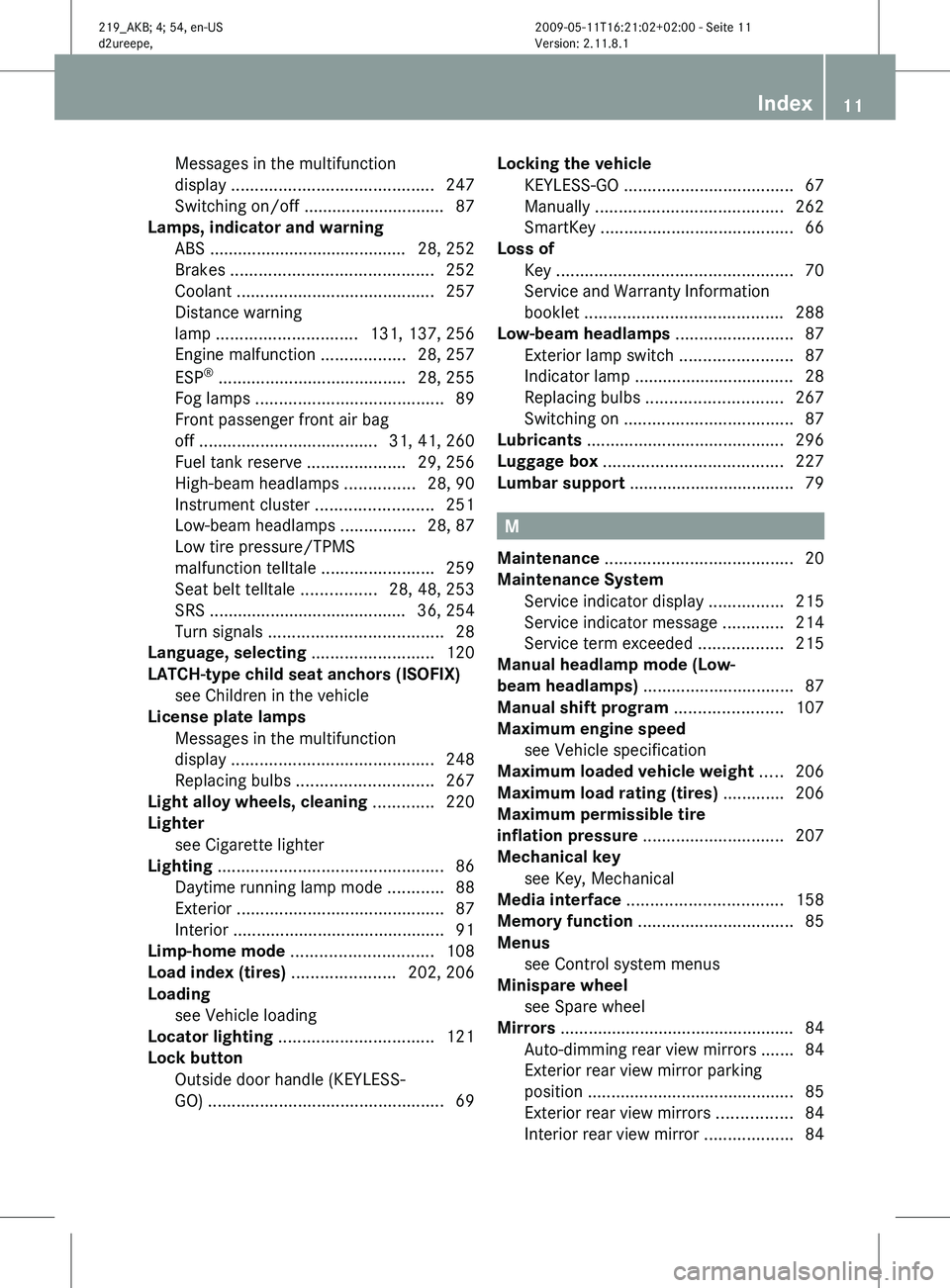
Messages in the multifunction
display
........................................... 247
Switching on/off .............................. 87
Lamps, indicator and warning
ABS .......................................... 28, 252
Brakes ........................................... 252
Coolant .......................................... 257
Distance warning
lamp .............................. 131, 137, 256
Engine malfunction .................. 28, 257
ESP ®
........................................ 28, 255
Fog lamps ........................................ 89
Front passenger front air bag
off ...................................... 31, 41, 260
Fuel tank reserve ..................... 29, 256
High-beam headlamps ...............28, 90
Instrument cluster .........................251
Low-beam headlamps ................ 28, 87
Low tire pressure/TPMS
malfunction telltale ........................ 259
Seat belt telltale ................28, 48, 253
SRS .......................................... 36, 254
Turn signals ..................................... 28
Language, selecting ..........................120
LATCH-type child seat anchors (ISOFIX) see Children in the vehicle
License plate lamps
Messages in the multifunction
display ........................................... 248
Replacing bulbs ............................. 267
Light alloy wheels, cleaning .............220
Lighter see Cigarette lighter
Lighting ................................................ 86
Daytime running lamp mode ............88
Exterior ............................................ 87
Interior ............................................. 91
Limp-home mode .............................. 108
Load index (tires) ......................202, 206
Loading see Vehicle loading
Locator lighting ................................. 121
Lock button
Outside door handle (KEYLESS-
GO) .................................................. 69Locking the vehicle
KEYLESS-GO .................................... 67
Manually ........................................ 262
SmartKey ......................................... 66
Loss of
Key .................................................. 70
Service and Warranty Information
booklet .......................................... 288
Low-beam headlamps ......................... 87
Exterior lamp switch ........................ 87
Indicator lamp .................................. 28
Replacing bulbs ............................. 267
Switching on .................................... 87
Lubricants .......................................... 296
Luggage box ...................................... 227
Lumbar support ................................... 79 M
Maintenance ........................................ 20
Maintenance System Service indicator display
................215
Service indicator message ............. 214
Service term exceeded ..................215
Manual headlamp mode (Low-
beam headlamps) ................................ 87
Manual shift program .......................107
Maximum engine speed see Vehicle specification
Maximum loaded vehicle weight .....206
Maximum load rating (tires) .............206
Maximum permissible tire
inflation pressure .............................. 207
Mechanical key see Key, Mechanical
Media interface ................................. 158
Memory function ................................. 85
Menus see Control system menus
Minispare wheel
see Spare wheel
Mirrors .................................................. 84
Auto-dimming rear view mirrors ....... 84
Exterior rear view mirror parking
position ............................................ 85
Exterior rear view mirrors ................ 84
Interior rear view mirror ................... 84 Index
11 219_AKB; 4; 54, en-US
d2ureepe,
Version: 2.11.8.1 2009-05-11T16:21:02+02:00 - Seite 11
Page 14 of 308
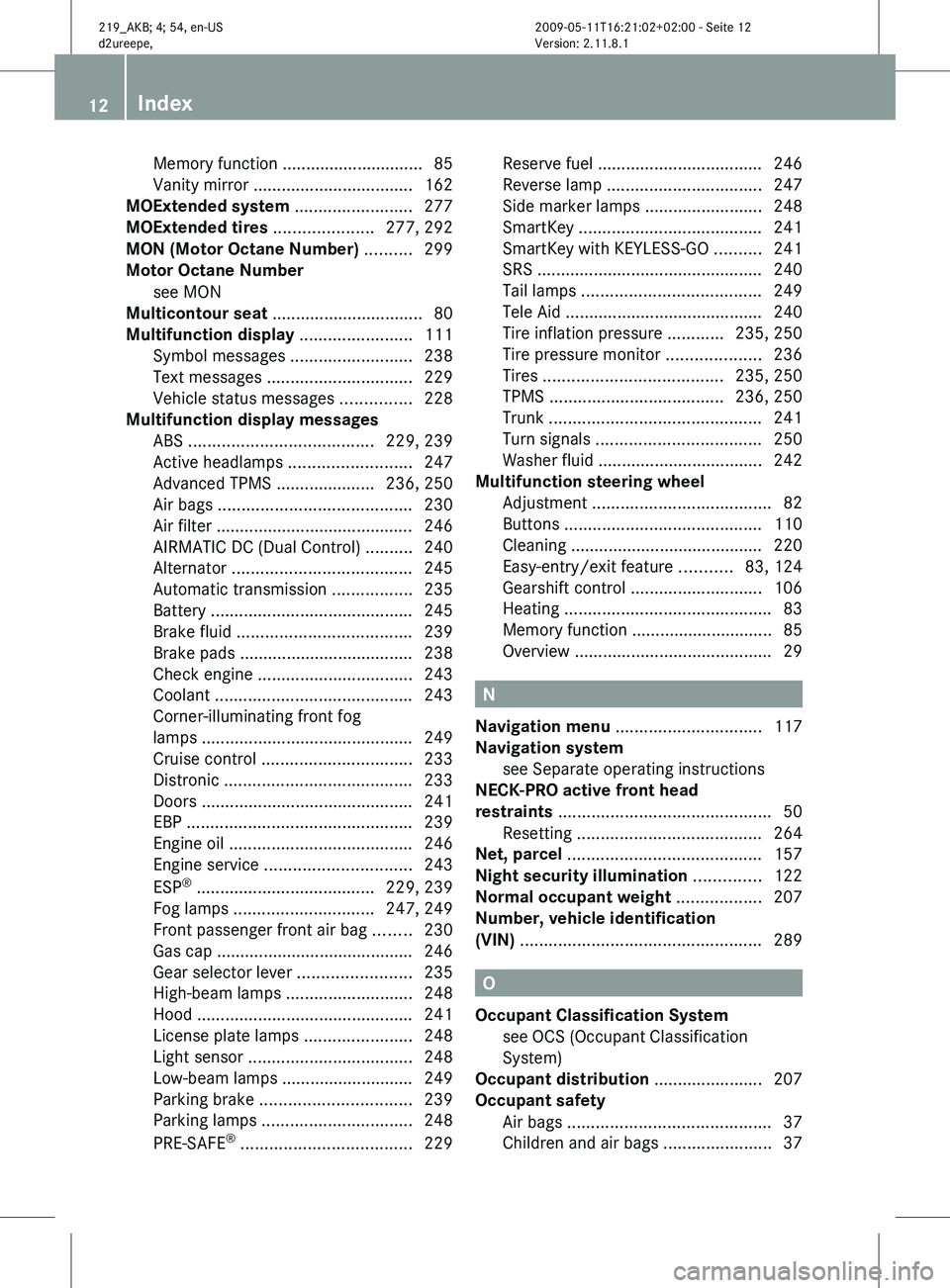
Memory function .............................. 85
Vanity mirror ..................................
162
MOExtended system ......................... 277
MOExtended tires ..................... 277, 292
MON (Motor Octane Number) ..........299
Motor Octane Number see MON
Multicontour seat ................................ 80
Multifunction display ........................ 111
Symbol messages .......................... 238
Text messages ............................... 229
Vehicle status messages ............... 228
Multifunction display messages
ABS ....................................... 229, 239
Active headlamps .......................... 247
Advanced TPMS ..................... 236, 250
Air bags ......................................... 230
Air filter .......................................... 246
AIRMATIC DC (Dual Control) .......... 240
Alternator ...................................... 245
Automatic transmission ................. 235
Battery ........................................... 245
Brake fluid ..................................... 239
Brake pads ..................................... 238
Check engine ................................. 243
Coolant .......................................... 243
Corner-illuminating front fog
lamps ............................................. 249
Cruise control ................................ 233
Distronic ........................................ 233
Doors ............................................. 241
EBP ................................................ 239
Engine oil ....................................... 246
Engine service ............................... 243
ESP ®
...................................... 229, 239
Fog lamps .............................. 247, 249
Front passenger front air bag ........230
Gas cap .......................................... 246
Gear selector lever ........................235
High-beam lamps ........................... 248
Hood .............................................. 241
License plate lamps ....................... 248
Light sensor ................................... 248
Low-beam lamps ............................ 249
Parking brake ................................ 239
Parking lamps ................................ 248
PRE-SAFE ®
.................................... 229Reserve fuel ...................................
246
Reverse lamp ................................. 247
Side marker lamps .........................248
SmartKey ....................................... 241
SmartKey with KEYLESS-GO ..........241
SRS ................................................ 240
Tail lamps ...................................... 249
Tele Aid .......................................... 240
Tire inflation pressure ............235, 250
Tire pressure monitor .................... 236
Tires ...................................... 235, 250
TPMS ..................................... 236, 250
Trunk ............................................. 241
Turn signals ................................... 250
Washer fluid ................................... 242
Multifunction steering wheel
Adjustment ...................................... 82
Buttons .......................................... 110
Cleaning ......................................... 220
Easy-entry/exit feature ...........83, 124
Gearshift control ............................ 106
Heating ............................................ 83
Memory function .............................. 85
Overview .......................................... 29 N
Navigation menu ............................... 117
Navigation system see Separate operating instructions
NECK-PRO active front head
restraints ............................................. 50
Resetting ....................................... 264
Net, parcel ......................................... 157
Night security illumination .............. 122
Normal occupant weight .................. 207
Number, vehicle identification
(VIN) ................................................... 289 O
Occupant Classification System see
OCS (Occupant Classification
System)
Occupant distribution ....................... 207
Occupant safety Air bags ........................................... 37
Children and air bags ....................... 3712
Index 219_AKB; 4; 54, en-US
d2ureepe,
Version: 2.11.8.1 2009-05-11T16:21:02+02:00 - Seite 12
Page 52 of 308
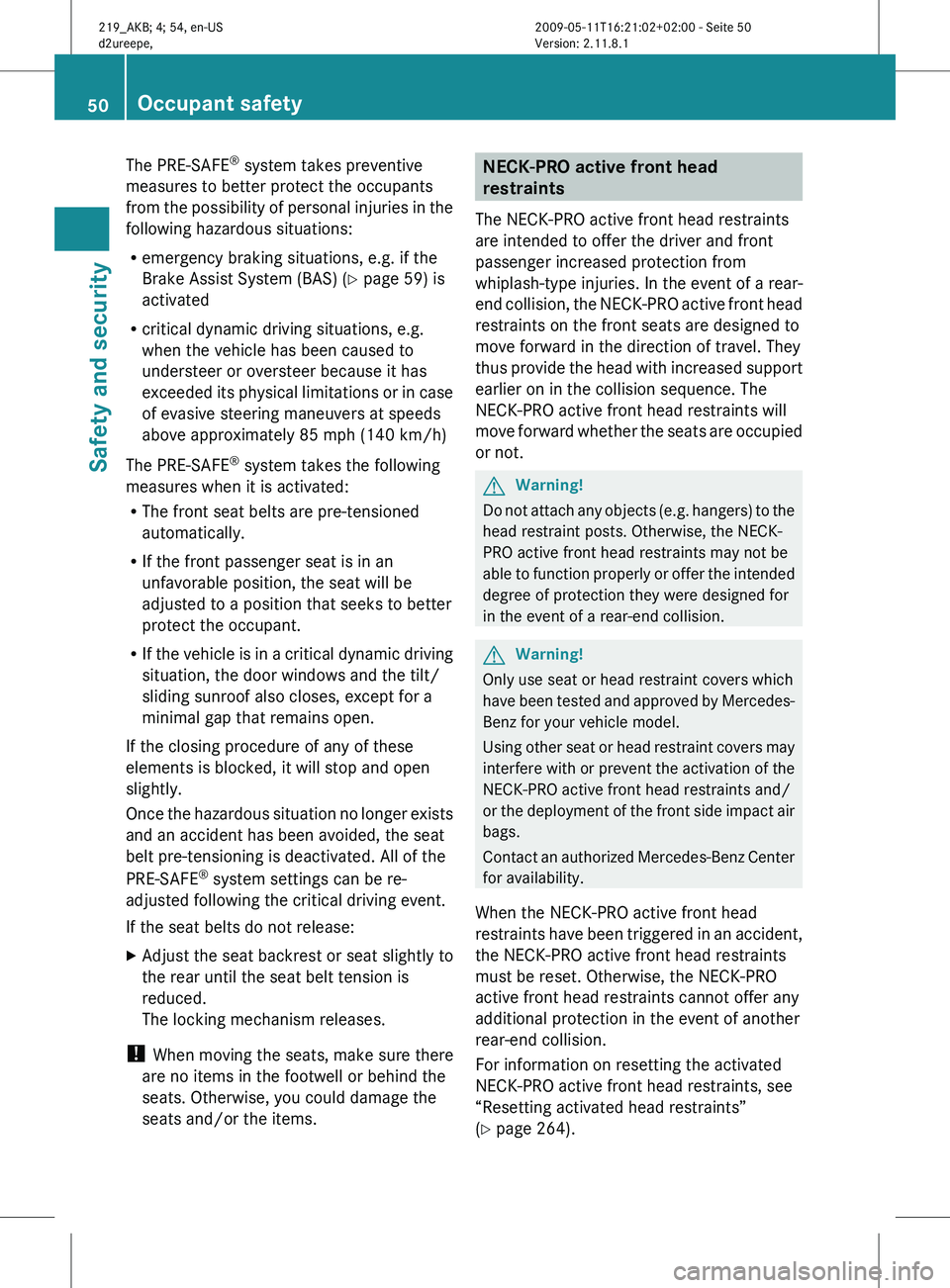
The PRE-SAFE
®
system takes preventive
measures to better protect the occupants
from
the possibility of personal injuries in the
following hazardous situations:
R emergency braking situations, e.g. if the
Brake Assist System (BAS) ( Y page 59) is
activated
R critical dynamic driving situations, e.g.
when the vehicle has been caused to
understeer or oversteer because it has
exceeded its physical limitations or in case
of evasive steering maneuvers at speeds
above approximately 85 mph (140 km/h)
The PRE-SAFE ®
system takes the following
measures when it is activated:
R The front seat belts are pre-tensioned
automatically.
R If the front passenger seat is in an
unfavorable position, the seat will be
adjusted to a position that seeks to better
protect the occupant.
R If the vehicle is in a critical dynamic driving
situation, the door windows and the tilt/
sliding sunroof also closes, except for a
minimal gap that remains open.
If the closing procedure of any of these
elements is blocked, it will stop and open
slightly.
Once the hazardous situation no longer exists
and an accident has been avoided, the seat
belt pre-tensioning is deactivated. All of the
PRE-SAFE ®
system settings can be re-
adjusted following the critical driving event.
If the seat belts do not release:
X Adjust the seat backrest or seat slightly to
the rear until the seat belt tension is
reduced.
The locking mechanism releases.
! When moving the seats, make sure there
are no items in the footwell or behind the
seats. Otherwise, you could damage the
seats and/or the items. NECK-PRO active front head
restraints
The NECK-PRO active front head restraints
are intended to offer the driver and front
passenger increased protection from
whiplash-type injuries. In the event of a rear-
end
collision, the NECK-PRO active front head
restraints on the front seats are designed to
move forward in the direction of travel. They
thus provide the head with increased support
earlier on in the collision sequence. The
NECK-PRO active front head restraints will
move forward whether the seats are occupied
or not. G
Warning!
Do not attach any objects (e.g. hangers) to the
head restraint posts. Otherwise, the NECK-
PRO active front head restraints may not be
able
to function properly or offer the intended
degree of protection they were designed for
in the event of a rear-end collision. G
Warning!
Only use seat or head restraint covers which
have
been tested and approved by Mercedes-
Benz for your vehicle model.
Using other seat or head restraint covers may
interfere with or prevent the activation of the
NECK-PRO active front head restraints and/
or the deployment of the front side impact air
bags.
Contact an authorized Mercedes-Benz Center
for availability.
When the NECK-PRO active front head
restraints have been triggered in an accident,
the NECK-PRO active front head restraints
must be reset. Otherwise, the NECK-PRO
active front head restraints cannot offer any
additional protection in the event of another
rear-end collision.
For information on resetting the activated
NECK-PRO active front head restraints, see
“Resetting activated head restraints”
(Y page 264). 50
Occupant safety
Safety and security
219_AKB; 4; 54, en-US
d2ureepe,
Version: 2.11.8.1 2009-05-11T16:21:02+02:00 - Seite 50
Page 54 of 308
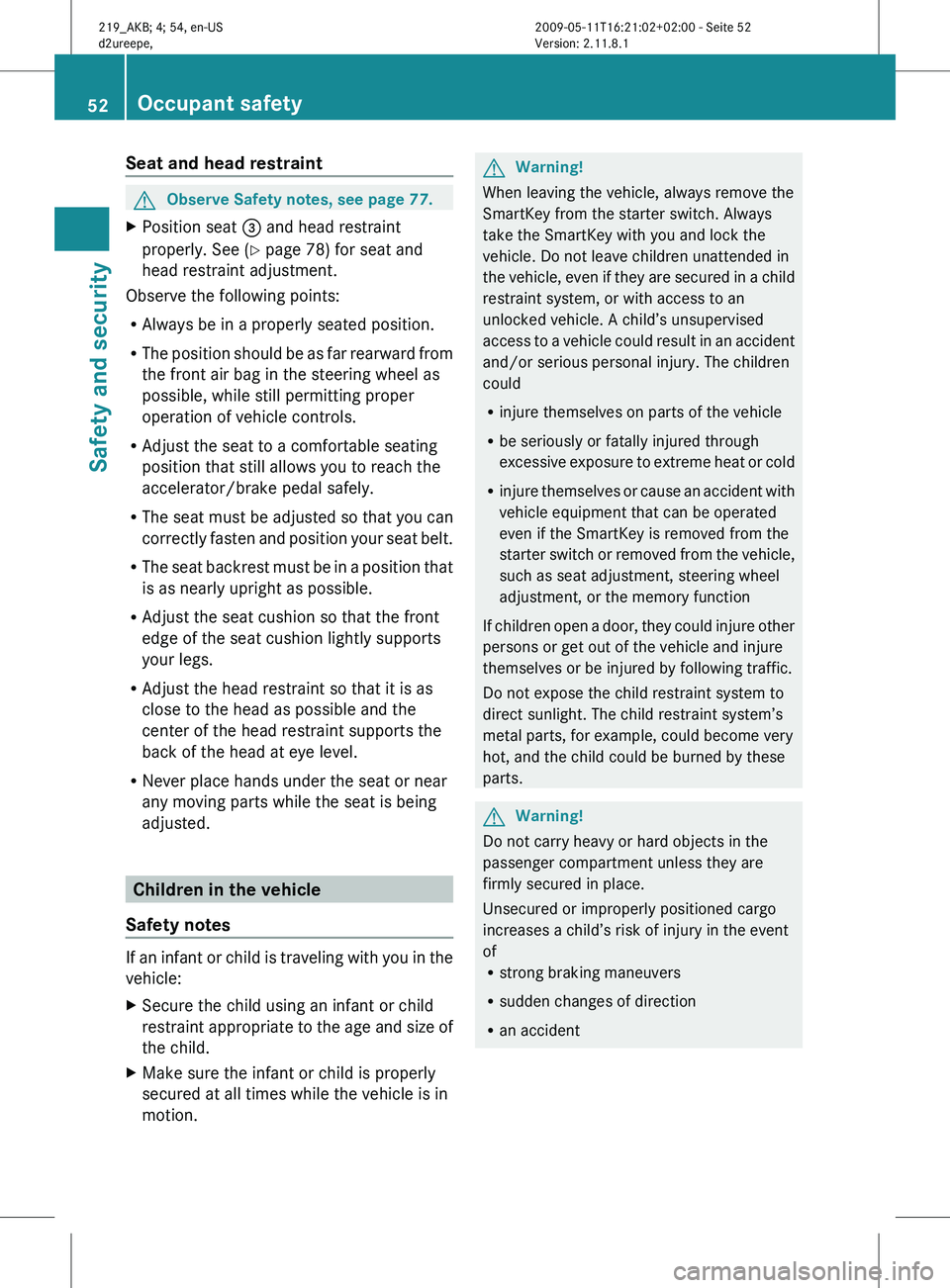
Seat and head restraint
G
Observe Safety notes, see page 77.
X Position seat = and head restraint
properly. See ( Y page 78) for seat and
head restraint adjustment.
Observe the following points:
R Always be in a properly seated position.
R The
position should be as far rearward from
the front air bag in the steering wheel as
possible, while still permitting proper
operation of vehicle controls.
R Adjust the seat to a comfortable seating
position that still allows you to reach the
accelerator/brake pedal safely.
R The seat must be adjusted so that you can
correctly fasten and position your seat belt.
R The seat backrest must be in a position that
is as nearly upright as possible.
R Adjust the seat cushion so that the front
edge of the seat cushion lightly supports
your legs.
R Adjust the head restraint so that it is as
close to the head as possible and the
center of the head restraint supports the
back of the head at eye level.
R Never place hands under the seat or near
any moving parts while the seat is being
adjusted. Children in the vehicle
Safety notes If an infant or child is traveling with you in the
vehicle:
X
Secure the child using an infant or child
restraint
appropriate to the age and size of
the child.
X Make sure the infant or child is properly
secured at all times while the vehicle is in
motion. G
Warning!
When leaving the vehicle, always remove the
SmartKey from the starter switch. Always
take the SmartKey with you and lock the
vehicle. Do not leave children unattended in
the
vehicle, even if they are secured in a child
restraint system, or with access to an
unlocked vehicle. A child’s unsupervised
access to a vehicle could result in an accident
and/or serious personal injury. The children
could
R injure themselves on parts of the vehicle
R be seriously or fatally injured through
excessive exposure to extreme heat or cold
R injure themselves or cause an accident with
vehicle equipment that can be operated
even if the SmartKey is removed from the
starter switch or removed from the vehicle,
such as seat adjustment, steering wheel
adjustment, or the memory function
If children open a door, they could injure other
persons or get out of the vehicle and injure
themselves or be injured by following traffic.
Do not expose the child restraint system to
direct sunlight. The child restraint system’s
metal parts, for example, could become very
hot, and the child could be burned by these
parts. G
Warning!
Do not carry heavy or hard objects in the
passenger compartment unless they are
firmly secured in place.
Unsecured or improperly positioned cargo
increases a child’s risk of injury in the event
of
R strong braking maneuvers
R sudden changes of direction
R an accident 52
Occupant safety
Safety and security
219_AKB; 4; 54, en-US
d2ureepe,
Version: 2.11.8.1 2009-05-11T16:21:02+02:00 - Seite 52
Page 60 of 308

achieved with winter tires, or snow chains
as required.
Safety notes G
Warning!
The following factors increase the risk of
accidents:
R Excessive speed, especially in turns
R Wet and slippery road surfaces
R Following another vehicle too closely
The driving safety systems described in this
section cannot reduce these risks or prevent
the
natural laws of physics from acting on the
vehicle. They cannot increase braking or
steering efficiency beyond that afforded by
the condition of the vehicle brakes and tires
or the traction afforded.
Only a safe, attentive, and skillful driver can
prevent accidents.
The capabilities of a vehicle equipped with the
driving safety systems described in this
section must never be exploited in a reckless
or dangerous manner which could jeopardize
the user’s safety or the safety of others.
Always adjust your driving style to the
prevailing road and weather conditions and
keep a safe distance to other road users and
objects on the street.
If a driving system malfunctions, other driving
safety systems may also switch off. Observe
indicator and warning lamps that may come
on as well as messages in the multifunction
display that may appear. ABS
G
Observe Safety notes, see page 58. G
Warning!
Do not pump the brake pedal. Use firm, steady
brake pedal pressure instead. Pumping the
brake pedal defeats the purpose of the ABS and significantly reduces braking
effectiveness.
The Antilock Brake System (ABS) regulates
the
brake pressure so that the wheels do not
lock during braking. This allows you to
maintain the ability to steer your vehicle.
The ABS is functional above a speed of
approximately 5 mph (8 km/h) independent
of road surface conditions.
On slippery road surfaces, the ABS will
respond even to light brake pressure.
The ABS indicator lamp ! in the
instrument cluster comes on when you switch
on the ignition. It goes out when the engine
is running.
Braking At the instant one of the wheels is about to
lock up, a slight pulsation can be felt in the
brake pedal. The pulsation indicates that the
ABS is in the regulating mode.
X
Keep firm and steady pressure on the brake
pedal while you feel the pulsation.
Continuous, steady brake pedal pressure
yields the advantages provided by the ABS,
namely
braking power and the ability to steer
the vehicle.
The pulsating brake pedal can be an
indication of hazardous road conditions and
functions as a reminder to take extra care
while driving.
Emergency brake maneuver X
Keep continuous full pressure on the brake
pedal. G
Warning!
If the ABS malfunctions, other driving safety
systems
such as the BAS or the ESP ®
are also
switched off. Observe indicator and warning
lamps that may come on as well as messages
in the multifunction display that may appear. 58
Driving safety systems
Safety and security
219_AKB; 4; 54, en-US
d2ureepe,
Version: 2.11.8.1 2009-05-11T16:21:02+02:00 - Seite 58
Page 80 of 308
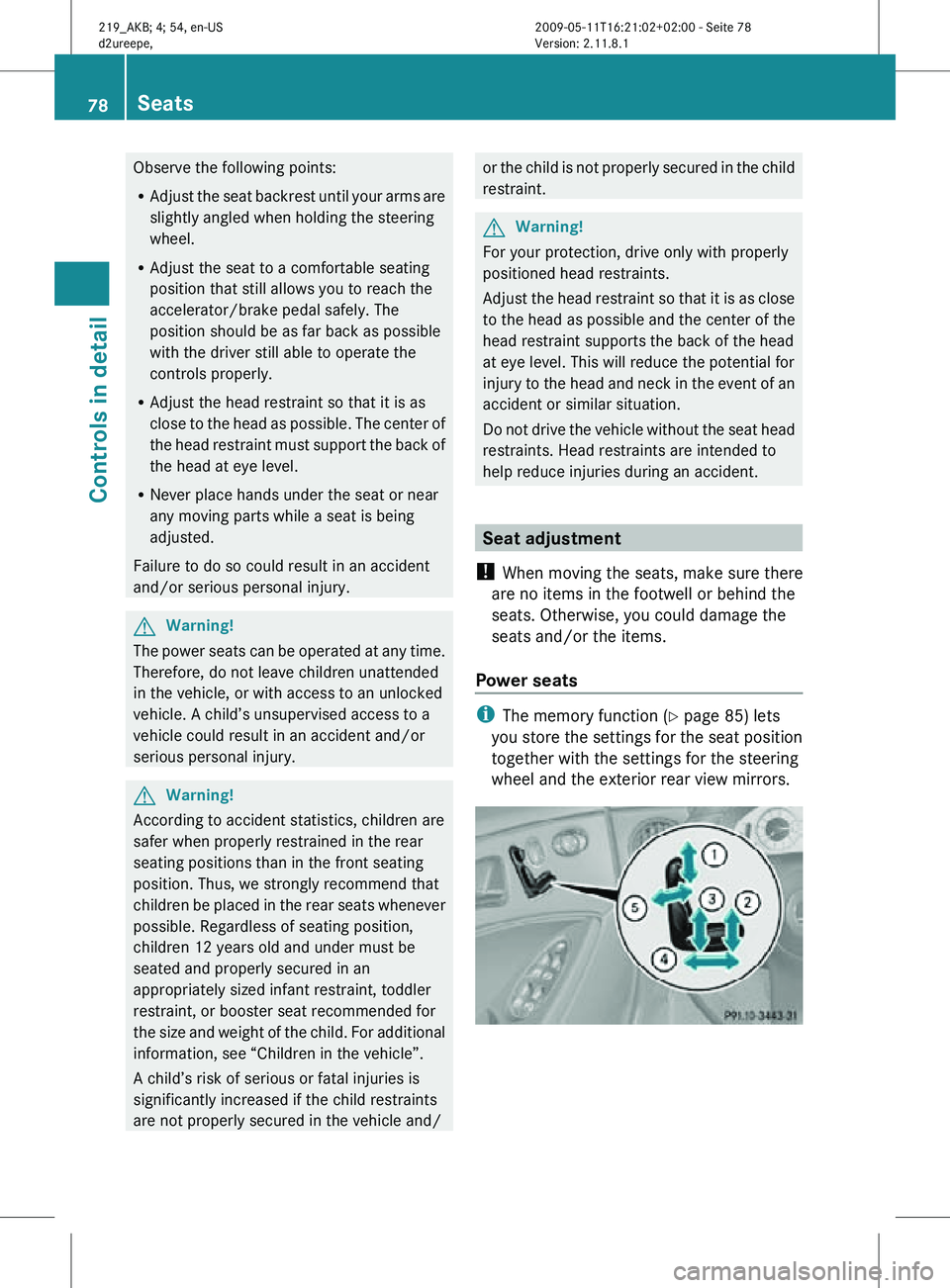
Observe the following points:
R
Adjust the seat backrest until your arms are
slightly angled when holding the steering
wheel.
R Adjust the seat to a comfortable seating
position that still allows you to reach the
accelerator/brake pedal safely. The
position should be as far back as possible
with the driver still able to operate the
controls properly.
R Adjust the head restraint so that it is as
close to the head as possible. The center of
the head restraint must support the back of
the head at eye level.
R Never place hands under the seat or near
any moving parts while a seat is being
adjusted.
Failure to do so could result in an accident
and/or serious personal injury. G
Warning!
The power seats can be operated at any time.
Therefore, do not leave children unattended
in the vehicle, or with access to an unlocked
vehicle. A child’s unsupervised access to a
vehicle could result in an accident and/or
serious personal injury. G
Warning!
According to accident statistics, children are
safer when properly restrained in the rear
seating positions than in the front seating
position. Thus, we strongly recommend that
children be placed in the rear seats whenever
possible. Regardless of seating position,
children 12 years old and under must be
seated and properly secured in an
appropriately sized infant restraint, toddler
restraint, or booster seat recommended for
the size and weight of the child. For additional
information, see “Children in the vehicle”.
A child’s risk of serious or fatal injuries is
significantly increased if the child restraints
are not properly secured in the vehicle and/ or the child is not properly secured in the child
restraint.
G
Warning!
For your protection, drive only with properly
positioned head restraints.
Adjust the head restraint so that it is as close
to the head as possible and the center of the
head restraint supports the back of the head
at eye level. This will reduce the potential for
injury to the head and neck in the event of an
accident or similar situation.
Do not drive the vehicle without the seat head
restraints. Head restraints are intended to
help reduce injuries during an accident. Seat adjustment
! When moving the seats, make sure there
are no items in the footwell or behind the
seats. Otherwise, you could damage the
seats and/or the items.
Power seats i
The memory function (Y page 85) lets
you store the settings for the seat position
together with the settings for the steering
wheel and the exterior rear view mirrors. 78
SeatsControls in detail
219_AKB; 4; 54, en-US
d2ureepe,
Version: 2.11.8.1 2009-05-11T16:21:02+02:00 - Seite 78
Page 90 of 308
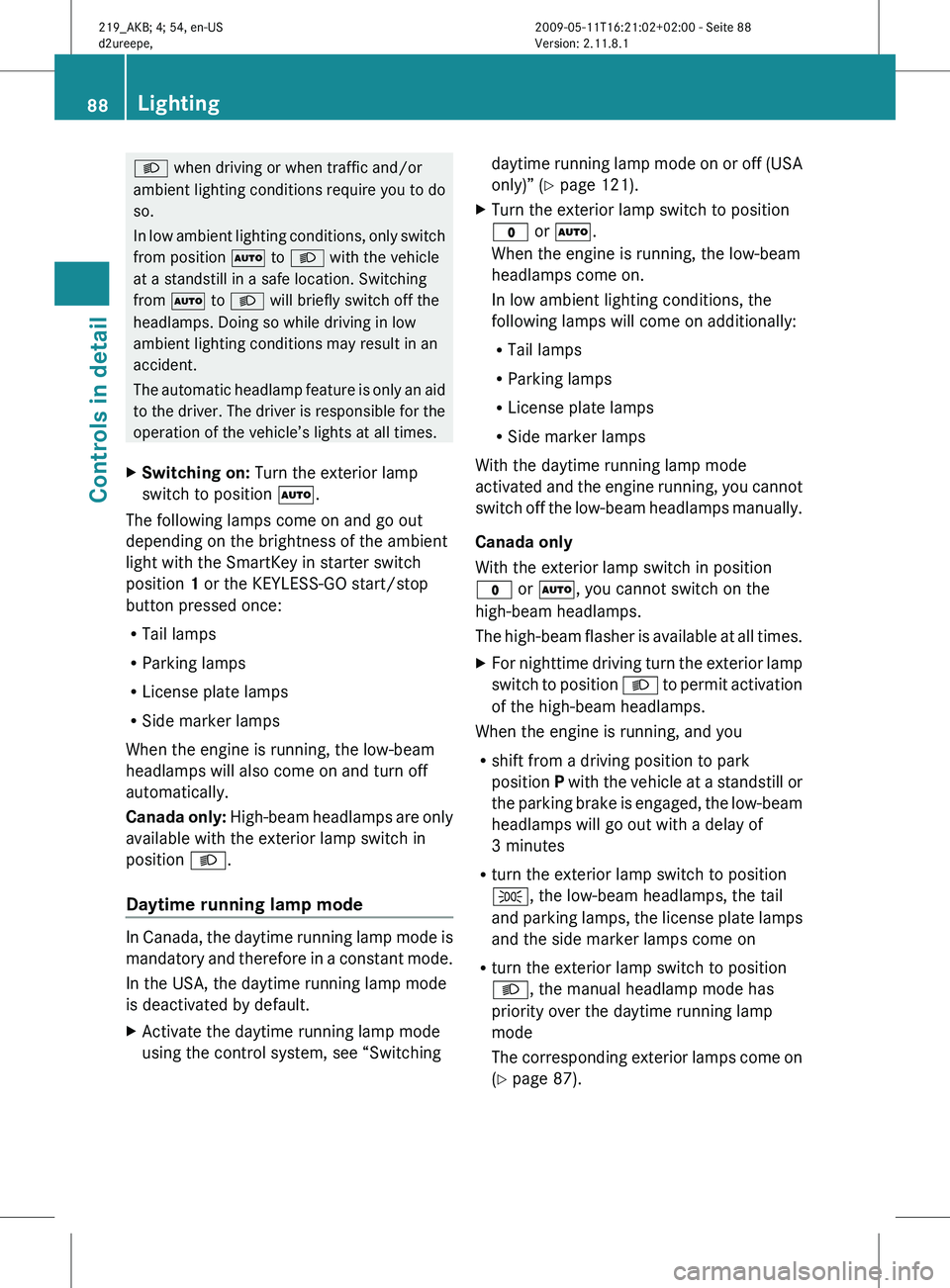
L when driving or when traffic and/or
ambient lighting conditions require you to do
so.
In
low ambient lighting conditions, only switch
from position à to L with the vehicle
at a standstill in a safe location. Switching
from à to L will briefly switch off the
headlamps. Doing so while driving in low
ambient lighting conditions may result in an
accident.
The automatic headlamp feature is only an aid
to the driver. The driver is responsible for the
operation of the vehicle’s lights at all times.
X Switching on: Turn the exterior lamp
switch to position Ã.
The following lamps come on and go out
depending on the brightness of the ambient
light with the SmartKey in starter switch
position 1 or the KEYLESS-GO start/stop
button pressed once:
R Tail lamps
R Parking lamps
R License plate lamps
R Side marker lamps
When the engine is running, the low-beam
headlamps will also come on and turn off
automatically.
Canada
only: High-beam headlamps are only
available with the exterior lamp switch in
position L.
Daytime running lamp mode In Canada, the daytime running lamp mode is
mandatory
and therefore in a constant mode.
In the USA, the daytime running lamp mode
is deactivated by default.
X Activate the daytime running lamp mode
using the control system, see “Switching daytime running lamp mode on or off (USA
only)”
(Y page 121).
X Turn the exterior lamp switch to position
$ or Ã.
When the engine is running, the low-beam
headlamps come on.
In low ambient lighting conditions, the
following lamps will come on additionally:
R
Tail lamps
R Parking lamps
R License plate lamps
R Side marker lamps
With the daytime running lamp mode
activated
and the engine running, you cannot
switch off the low-beam headlamps manually.
Canada only
With the exterior lamp switch in position
$ or Ã, you cannot switch on the
high-beam headlamps.
The high-beam flasher is available at all times.
X For nighttime driving turn the exterior lamp
switch
to position L to permit activation
of the high-beam headlamps.
When the engine is running, and you
R shift from a driving position to park
position P
with the vehicle at a standstill or
the parking brake is engaged, the low-beam
headlamps will go out with a delay of
3 minutes
R turn the exterior lamp switch to position
T, the low-beam headlamps, the tail
and parking lamps, the license plate lamps
and the side marker lamps come on
R turn the exterior lamp switch to position
L, the manual headlamp mode has
priority over the daytime running lamp
mode
The corresponding exterior lamps come on
(Y page 87). 88
Lighting
Controls in detail
219_AKB; 4; 54, en-US
d2ureepe,
Version: 2.11.8.1 2009-05-11T16:21:02+02:00 - Seite 88
Page 96 of 308
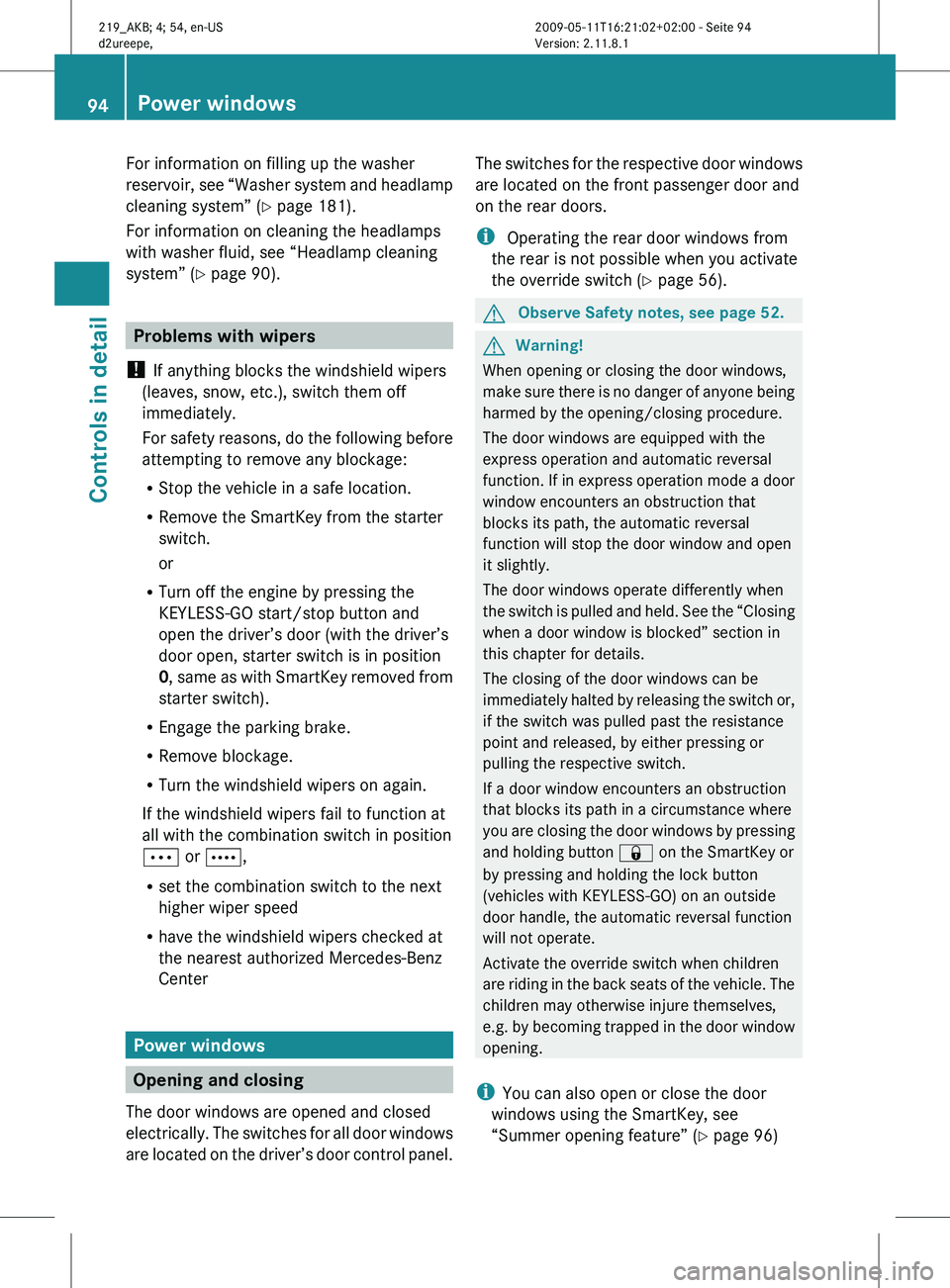
For information on filling up the washer
reservoir,
see “Washer system and headlamp
cleaning system” ( Y page 181).
For information on cleaning the headlamps
with washer fluid, see “Headlamp cleaning
system” ( Y page 90). Problems with wipers
! If anything blocks the windshield wipers
(leaves, snow, etc.), switch them off
immediately.
For
safety reasons, do the following before
attempting to remove any blockage:
R Stop the vehicle in a safe location.
R Remove the SmartKey from the starter
switch.
or
R Turn off the engine by pressing the
KEYLESS-GO start/stop button and
open the driver’s door (with the driver’s
door open, starter switch is in position
0, same as with SmartKey removed from
starter switch).
R Engage the parking brake.
R Remove blockage.
R Turn the windshield wipers on again.
If the windshield wipers fail to function at
all with the combination switch in position
Ä or Å,
R set the combination switch to the next
higher wiper speed
R have the windshield wipers checked at
the nearest authorized Mercedes-Benz
Center Power windows
Opening and closing
The door windows are opened and closed
electrically.
The switches for all door windows
are located on the driver’s door control panel. The switches for the respective door windows
are located on the front passenger door and
on the rear doors.
i
Operating the rear door windows from
the rear is not possible when you activate
the override switch (Y page 56). G
Observe Safety notes, see page 52. G
Warning!
When opening or closing the door windows,
make
sure there is no danger of anyone being
harmed by the opening/closing procedure.
The door windows are equipped with the
express operation and automatic reversal
function. If in express operation mode a door
window encounters an obstruction that
blocks its path, the automatic reversal
function will stop the door window and open
it slightly.
The door windows operate differently when
the switch is pulled and held. See the “Closing
when a door window is blocked” section in
this chapter for details.
The closing of the door windows can be
immediately halted by releasing the switch or,
if the switch was pulled past the resistance
point and released, by either pressing or
pulling the respective switch.
If a door window encounters an obstruction
that blocks its path in a circumstance where
you are closing the door windows by pressing
and holding button & on the SmartKey or
by pressing and holding the lock button
(vehicles with KEYLESS-GO) on an outside
door handle, the automatic reversal function
will not operate.
Activate the override switch when children
are riding in the back seats of the vehicle. The
children may otherwise injure themselves,
e.g. by becoming trapped in the door window
opening.
i You can also open or close the door
windows using the SmartKey, see
“Summer opening feature” ( Y page 96)94
Power windows
Controls in detail
219_AKB; 4; 54, en-US
d2ureepe,
Version: 2.11.8.1 2009-05-11T16:21:02+02:00 - Seite 94
Page 102 of 308
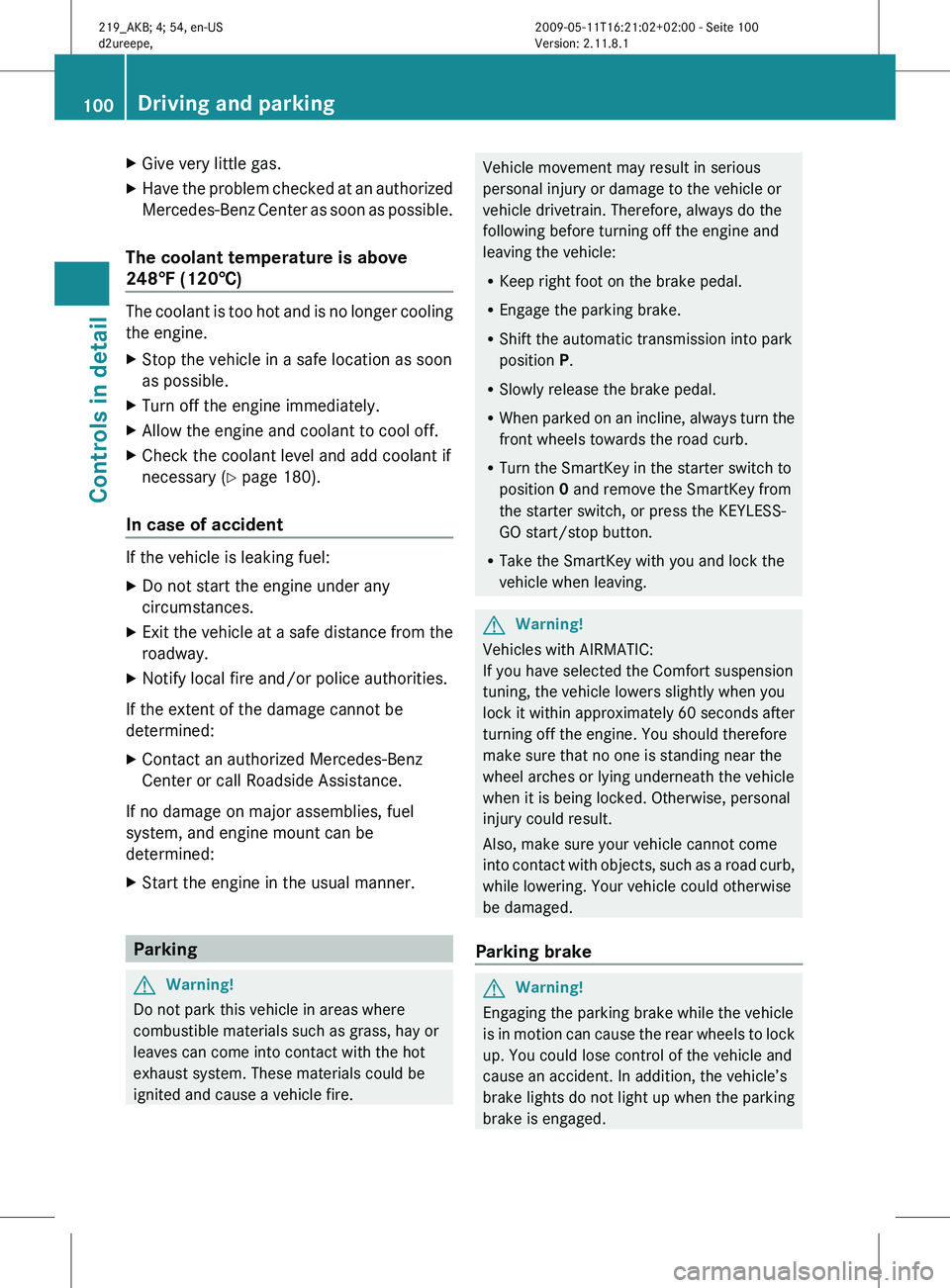
X
Give very little gas.
X Have the problem checked at an authorized
Mercedes-Benz
Center as soon as possible.
The coolant temperature is above
248‡
(120†) The coolant is too hot and is no longer cooling
the engine.
X
Stop the vehicle in a safe location as soon
as possible.
X Turn off the engine immediately.
X Allow the engine and coolant to cool off.
X Check the coolant level and add coolant if
necessary ( Y page 180).
In case of accident If the vehicle is leaking fuel:
X
Do not start the engine under any
circumstances.
X Exit the vehicle at a safe distance from the
roadway.
X Notify local fire and/or police authorities.
If the extent of the damage cannot be
determined:
X Contact an authorized Mercedes-Benz
Center or call Roadside Assistance.
If no damage on major assemblies, fuel
system, and engine mount can be
determined:
X Start the engine in the usual manner. Parking
G
Warning!
Do not park this vehicle in areas where
combustible materials such as grass, hay or
leaves can come into contact with the hot
exhaust system. These materials could be
ignited and cause a vehicle fire. Vehicle movement may result in serious
personal injury or damage to the vehicle or
vehicle drivetrain. Therefore, always do the
following before turning off the engine and
leaving the vehicle:
R
Keep right foot on the brake pedal.
R Engage the parking brake.
R Shift the automatic transmission into park
position P.
R Slowly release the brake pedal.
R When
parked on an incline, always turn the
front wheels towards the road curb.
R Turn the SmartKey in the starter switch to
position 0 and remove the SmartKey from
the starter switch, or press the KEYLESS-
GO start/stop button.
R Take the SmartKey with you and lock the
vehicle when leaving. G
Warning!
Vehicles with AIRMATIC:
If you have selected the Comfort suspension
tuning, the vehicle lowers slightly when you
lock
it within approximately 60 seconds after
turning off the engine. You should therefore
make sure that no one is standing near the
wheel arches or lying underneath the vehicle
when it is being locked. Otherwise, personal
injury could result.
Also, make sure your vehicle cannot come
into contact with objects, such as a road curb,
while lowering. Your vehicle could otherwise
be damaged.
Parking brake G
Warning!
Engaging the parking brake while the vehicle
is
in motion can cause the rear wheels to lock
up. You could lose control of the vehicle and
cause an accident. In addition, the vehicle’s
brake lights do not light up when the parking
brake is engaged. 100
Driving and parking
Controls in detail
219_AKB; 4; 54, en-US
d2ureepe,
Version: 2.11.8.1 2009-05-11T16:21:02+02:00 - Seite 100